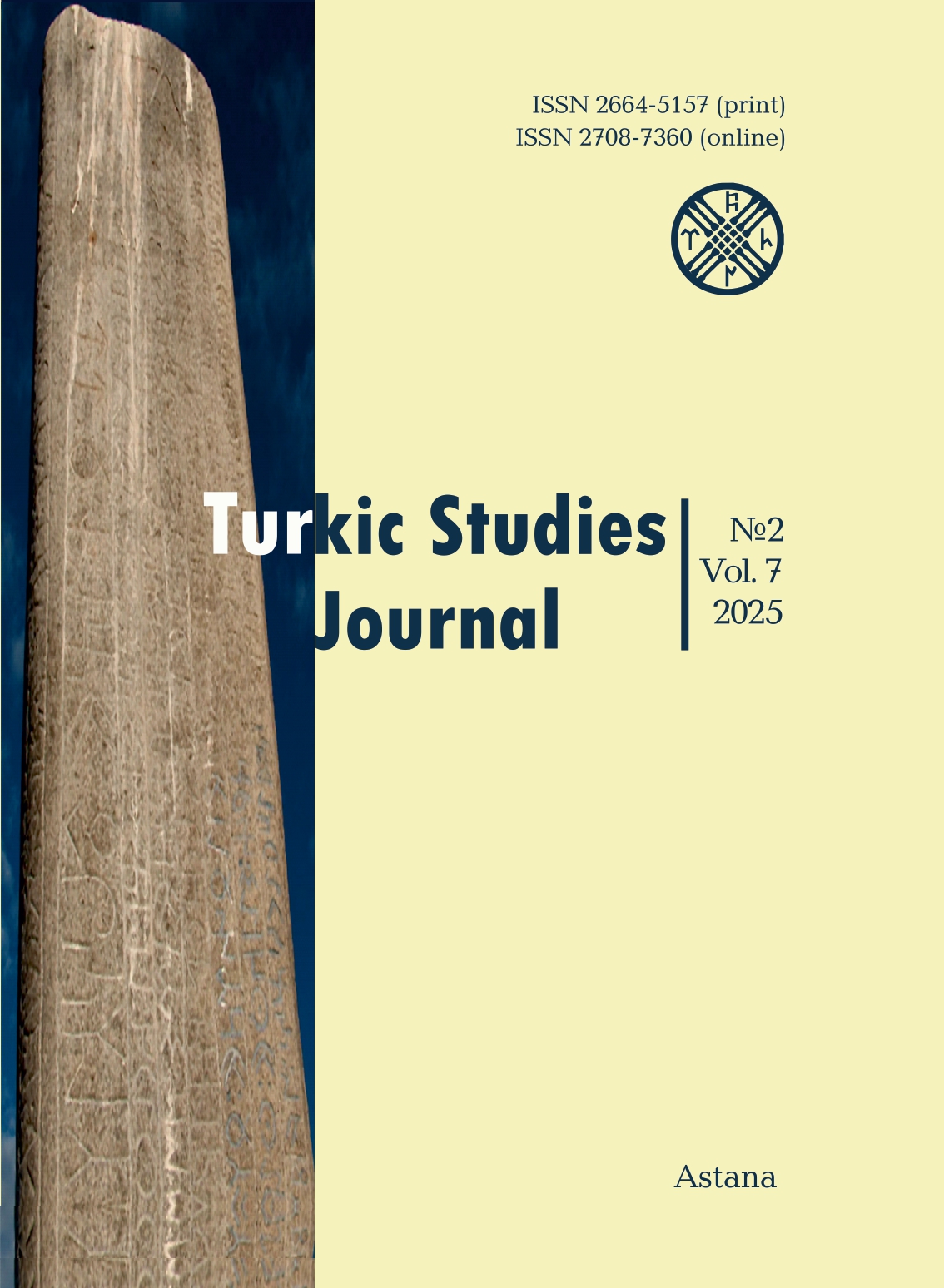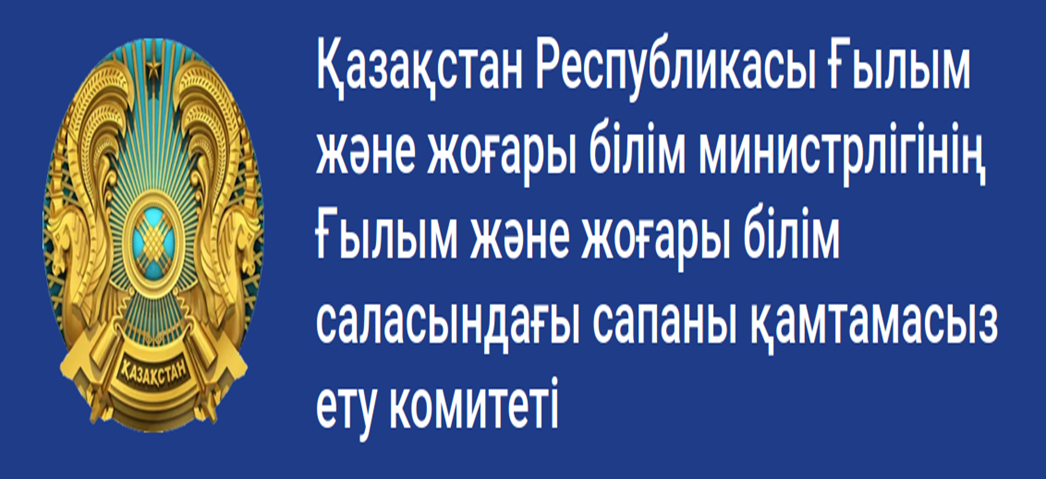The Mausoleums of Medieval Syganak
Views: 370 / PDF downloads: 148
DOI:
https://doi.org/10.32523/2664-5157-2025-2-26-43Keywords:
Syganak, medieval settlement, mausoleum, architectural monument, burial rite, glazed tiles, excavation, section, necropolis, archaeologyAbstract
The study of medieval necropolises in the middle and lower reaches of the Syr Darya River has long been a central focus of archaeological research. In the 20th century, the region's mausoleums in the region were investigated by scholars including V.A. Kallaur, A.Yu.Yakubovsky, S.P.Tolstov, S.E.Azhigali, K.M.Baipakov, M.Eleuov, and S.Zh.Zholdasbayev. Recent investigations of the architectural monuments of medieval Syganak have revealed unique spatial layouts, structural designs, and decorative elements of its mausoleums.
Syganak, referred to in historical sources as the ‘city of mausoleums,’ was a major political, spiritual, and commercial center in the middle Syr Darya region. Between the 13th and 15th centuries, it served successively as the capital of the White Horde, a constituent of the Great Ulus (Golden Horde), the Abulkhair Khanate, and the Kazakh Khanate. Unsurprisingly, rulers, spiritual leaders, and prominent figures were buried here, with monumental structures erected over their graves.
This article examines the dating and characteristics of seven mausoleums in medieval Syganak. A comprehensive review of available sources was conducted, including detailed descriptions and systematic data analysis. The mausoleums are portal- domed structures built of fired brick, with the interior walls of Mausoleum No. 4 constructed from adobe. They are decorated with carved terracotta and glazed tiles. Burials in Mausoleums Nos. 1, 3, 5, and 7 were placed in crypts, while Mausoleums Nos. 4 and 6 contained family crypts. Islamic burial rites were observed: the deceased were oriented northwest-southeast in Mausoleums
Nos. 3, 4, 5, 6, and 7, and north-south in Mausoleum No. 1. The discovery of iron nails in Mausoleums Nos. 3, 5, and 7 suggests the use of wooden coffins.
The study includes a comparative analysis of the architectural features of the mausoleums, supported by radiocarbon dating. The results establish the following chronological framework: Mausoleum No. 5 dates to the late 14th century; No. 6 to the early 15th century; No. 7 to the early 14th century; Nos. 1 and 3 to the 14th century; and No. 4 to the 14th–15th centuries.
Downloads
Reference
Армарчук Е.А., 2013. Декоративные надгробья Хорезма и Золотой Орды. ТГЭ. Вып. LXII. С. 408-430.
Байпаков К.М., 1973. Средневековое погребение в Илийской долине. СА. № 2. С. 257-259.
Байпаков К.М., 2012. Исламская ареологическая архитектура и археология Казахстана. Алматы: ТОО «Археологическая экспертиза». 284 c.
Байпаков К.М., Акылбек С.Ш., Воякин Д.А., Жолдасбаев С.Ж., 2014. Городище Сыгнак: Мавзолеи. Известия НАН РК. Вып. 5. Алматы. С. 45-51.
Воякин Д.А., Бахтыбаев М.М., Искандерова А.Д., 2025. Гавань Дешт-и-Кыпчака. Алматы Самарканд: «Международный институт центральноазиатских исследований». 304 с.
Barthold W.W., 1947. Türklerde ve Moğollarda Defin Merasimi Meselesine Dair. Belleten Cilt 11. Sayı 43. Рр.515-539.
Егоров В.Л., 1980. Мавзолеи Водянского городища. СА. № 1. С. 74-89.
Егоров В.Л., Федоров-Давыдов Г.А., 1976. Исследование мечети на Водянском городище. Средневековые памятники Поволжья. М.: Наука. С.108-167.
Зиливинская Э.Д. Мавзолеи восточных районов Золотой орды. Золотоордынское обозрение. 2024. Т. 12, № 1. С. 91-124. https://doi.org/10.22378/2313-6197.2024
Кожемяко П.Н., 1967. Раскопки жилищ горожан Х-ХІІ вв. на Краснореченском городище. Древняя и раннесредневековая культура Киргизстана. Фрунзе: Илим. С. 53-90.
Kozha M.B., Nurzhanov A.A., Krupko I., 2021. The Contribution of Researchers of the Russian Empire to the Study of Antiquities in Kazakhstan: the Case of N.I. Veselovsky. Bylye Gody. Vol.16. Iss. 2. Рр. 898-907.
Құрманқұлов Ж., 2011. (бас редактор). Қазақстан Республикасының тарихи мәдени ескерткіштерінің жинағы. Қызылорда облысы. Алматы: Аруна. 504 б.
Нагаминэ Х., 2020. Сыганак как «Порт Дашт-и Кыпчака» и «Города-Мавзолей»: период от правления левого крыла Джучидов до основания «Казахского ханства».
Золотоордынское обозерение. №8(5). C. 533-551. DOI: https://doi.org/10.22378/2313-6197.2020-83.533-551
Нурмуханбетов Б.Н., 1974. Раннемусульманское кладбище близ городища Куйрык тобе. В глубь веков. Алма-Ата: Наука. С. 85-94.
Петров П.Н., Смагулов Т.Н., 2018. Нумизматические находки XIV века из некрополя у озера Аулиеколь. Stratum plus. №6. С. 167-184.
Радлов В., 1899. Опыт словаря тюркских наречий. Том 2. Часть 2. Санк-Петербург: Типография Императорской Академия Наукь. 1174 с.
Смагулов Е.А., 2012. Намогильники сауранского некрополя и «сагона» Ходжа Ахмеда Ясави. Известия НАН РК. Серия общ. наук. №3 (283). Алматы. С. 108-125.
Sizdikov B.S., Baitanayev B.A., Murgabayev S.S., Bakhtybayev M.M., Arynov K.S., Gursoy M., Seraliyev A.A., 2023. Mausoleums ın the medıeval cıty of Syganak. Povolzhskaya arkheologıya. № 2 (44). P. 131-144. https://doi.org/10.24852/pa2023.2.44.131.144
REFERENCE
Armarchuk E.A., 2013. Dekorativnye nadgrobya Horezma i Zolotoi Ordy [Decorative tombstones of Khorezm and the Golden Horde]. TGE. Vyp. LXII. S. 408-430. [in Russian]
Baipakov K.M., 1973. Srednevekovoe pogrebenie v İliiskoi doline [Medieval burial in the Ili Valley]. SA. No 2. P. 257-259. [in Russian]
Baipakov K.M., 2012. İslamskaya areologicheskaya arhitektura i Arheologiya Kazahstana [Islamic Areological Architecture and Archaeology of Kazakhstan]. Almaty: TOO «Arheologicheskaya ekspertiza». 284 p. [in Russian]
Baipakov K.M., Akylbek S.Ş., Voyakin D.A., Joldasbaev S.J., 2014. Gorodishe Sygnak: Mavzolei [Sygnak ancient settlement: Mausoleums]. İzvestiya NAN RK. Vyp. 5. Almaty. P. 45-51. [in Russian]
Voyakin D.A., Bahtybaev M.M., İskanderova A.D., 2025. Gavan Deşt-i-Kypchaka [Harbor of Desht-i-Kipchak]. Almaty-Samarkand: «Mejdunarodnyi institut tsentralnoaziatskih issledovanii». 304 p. [in Russian]
Barthold W.W., 1947. Türklerde ve Moğollarda Defin Merasimi Meselesine Dair. Belleten Cilt 11. Sayı 43. P. 515-539. [in Turkısh]
Egorov V.L., 1980. Mavzolei Vodyanskogo gorodiщa [Research of the mosque at Vodyanskoye settlement]. SA. No 1. P. 74-89. [in Russian]
Egorov V.L., Fedorov-Davydov G.A., 1976. İssledovanie mecheti na Vodyanskom gorodishe [Research of the mosque at Vodyanskoye settlement]. Srednevekovye pamyatniki Povoljya. M.: Nauka. P. 108-167. [in Russian]
Zılıvınskaıa E.D. Mavzoleı vostochnyh raıonov Zolotoı Ordy [Mausoleums of the Eastern Regions of the Golden Horde]. Zolotoordynskoe obozrenıe. 2024. V. 12, No 1. P. 91–124. https://doi.org/10.22378/2313-6197.2024-12-1.91-124. [in Russian]
Kojemyako P.N., 1967. Raskopki jilish gorojan H-HII vv. na Krasnorechenskom gorodishe [Excavations of dwellings of citizens of the 10th-12th centuries at Krasnorechenskoye settlement]. Drevnyaya i rannesrednevekovaya kultura Kirgizstana. Frunze: İlim. P. 53-90. [in Russian]
Kozha M.B., Nurzhanov A.A., Krupko I., 2021. The Contribution of Researchers of the Russian Empire to the Study of Antiquities in Kazakhstan: the Case of N.I. Veselovsky. Bylye Gody. Vol.16. Iss. 2. Rr. 898-907. Qūrmanqūlov J., 2011. Qazaqstan Respublikasynyŋ tarihi mädeni eskertkıshterınıŋ jinağy. Qyzylorda oblysy [Collection of historical and cultural monuments of the Republic of Kazakhstan. Kyzylorda region]. Almaty: Aruna. 504 p. [in Kazakh]
Nagamine H., 2020. Syganak kak «Port Dasht-i Kypchaka» i «Goroda-Mavzolei»: period ot pravleniya levogo kryla Djuchidov do osnovaniya «Kazahskogo hanstva» [Syganak as the "Port of Dasht-i Kipchak" and "Mausoleum City": the period from the reign of the left wing of the Jochid to the foundation of the "Kazakh Khanate"]. Zolotoordynskoe obozerenie. 8(5). P. 533-551. DOI: 10.22378/2313-6197.2020-8-3.533-551 [in Russian]
Nurmuhanbetov B.N., 1974. Rannemusulmanskoe kladbishe bliz gorodisha Kuiryk-tobe [Early Muslim cemetery near the Kuyryk-tobe settlement]. V glub vekov. Alma-Ata: Nauka. P. 85-94. [in Russian]
Petrov P.N., Smagulov T.N., 2018. Numizmaticheskie nahodki XIV veka iz nekropolya u ozera Auliekol [Numismatic finds from the 14th century necropolis near Lake Auliekol]. Stratum plus. No6. P. 167-184. [in Russian]
Radlov V., 1899. Opyt slovarya tyurkskih narechii [An experiment in the dictionary of Turkic dialects]. Tom 2. Chast 2. Sank-Peterburg: Tipografiya İmperatorskoi Akademiya Nauk. 1174 p. [in Russian]
Smagulov E.A., 2012. Namogilniki sauranskogo nekropolya i «sagona» Hodja Ahmeda Yasavi [Burial grounds of the Sauran necropolis and the "sagon" of Khoja Akhmed Yasawi]. İzvestiya NAN RK. Seriya obsh. nauk. No3 (283). Almaty. P. 108-125. [in Russian]
Sizdikov B.S., Baitanayev B.A., Murgabayev S.S., Bakhtybayev M.M., Arynov K.S., Gursoy M., Seraliyev A.A., 2023. Mausoleums ın the medıeval cıty of Syganak. Povolzhskaya arkheologıya. No 2 (44). P. 131-144.
Downloads
Published
How to Cite
Issue
Section
License
Copyright (c) 2025 Turkic Studies Journal

This work is licensed under a Creative Commons Attribution-NonCommercial 4.0 International License.


























